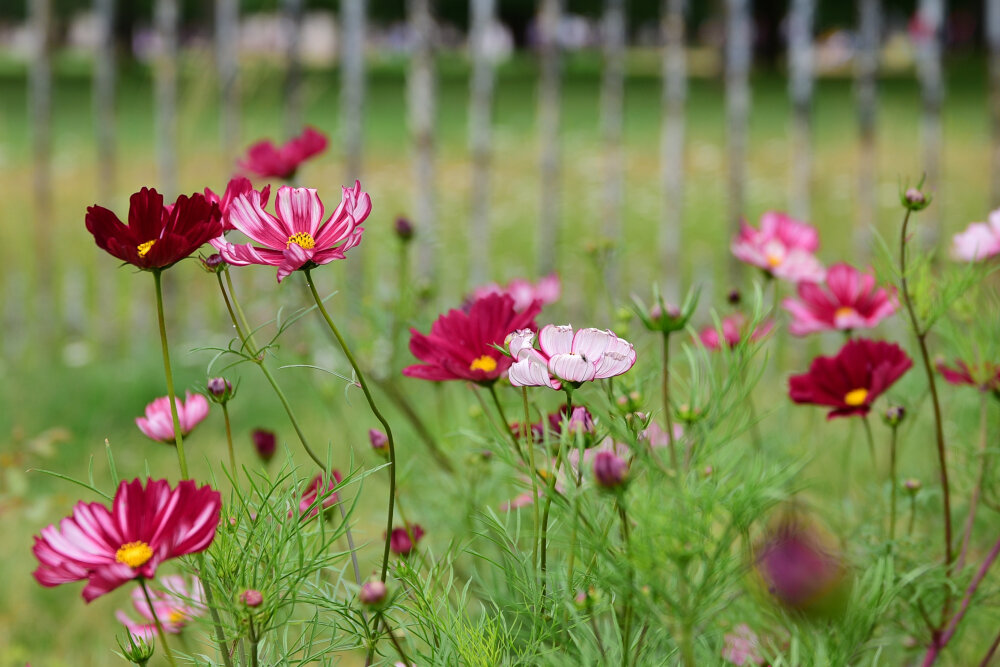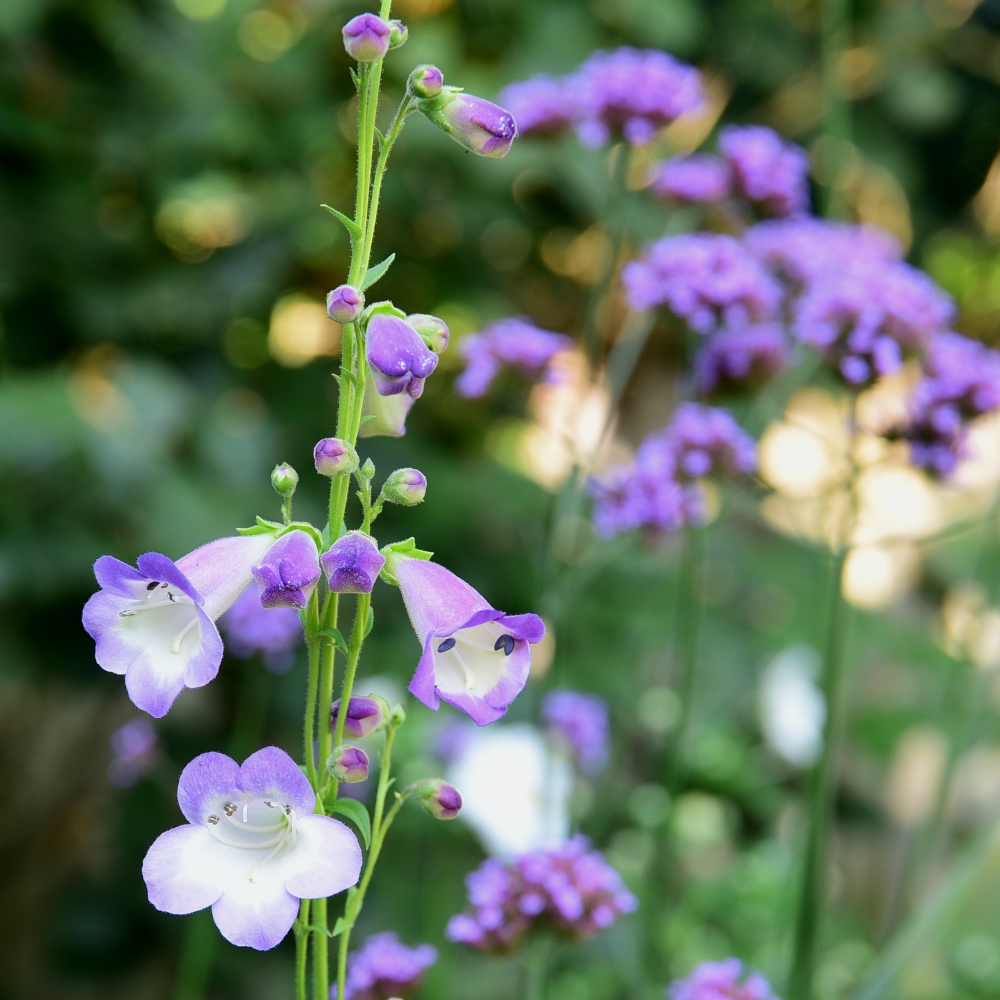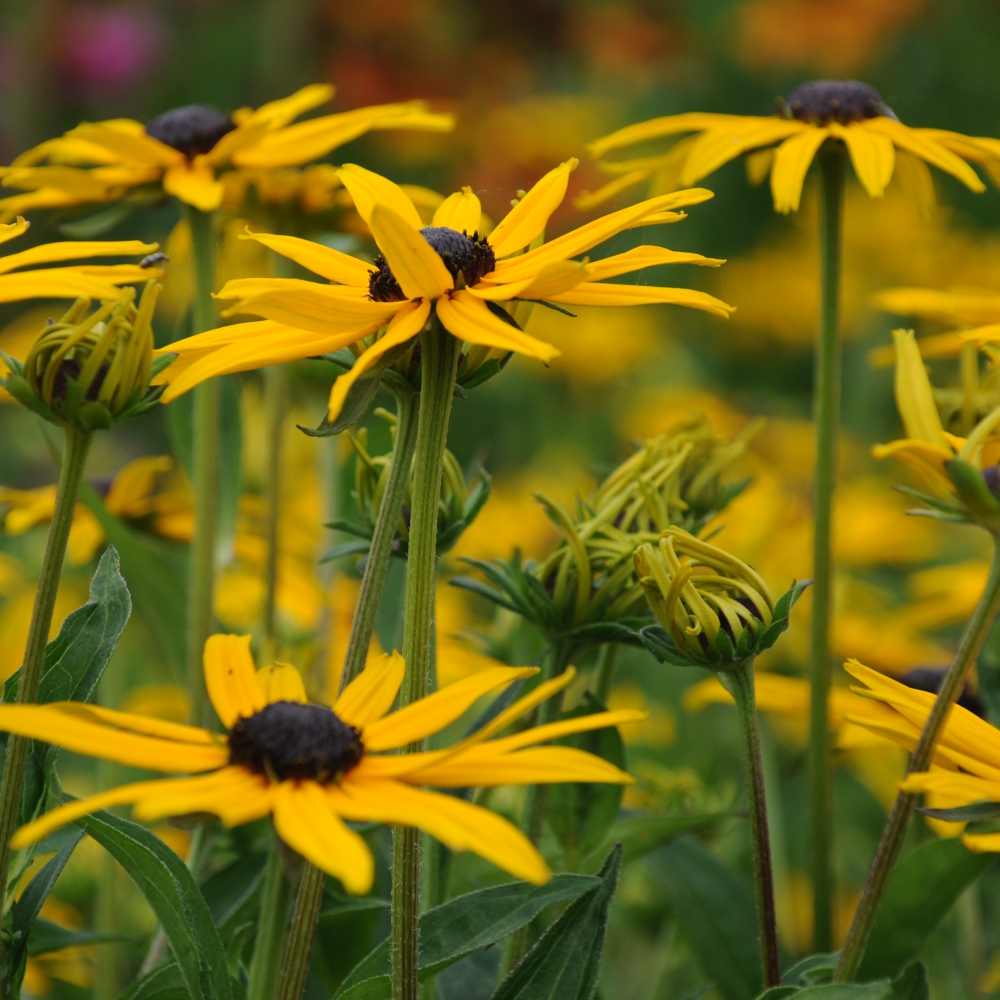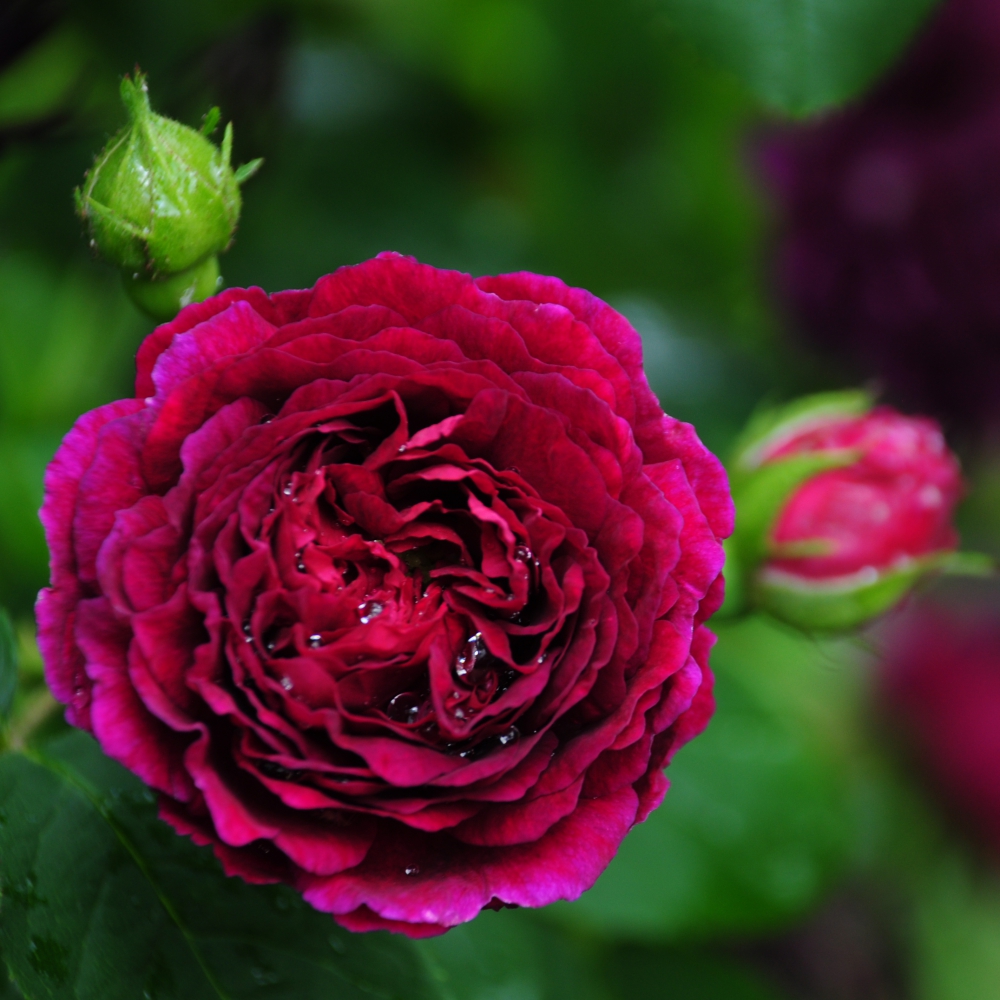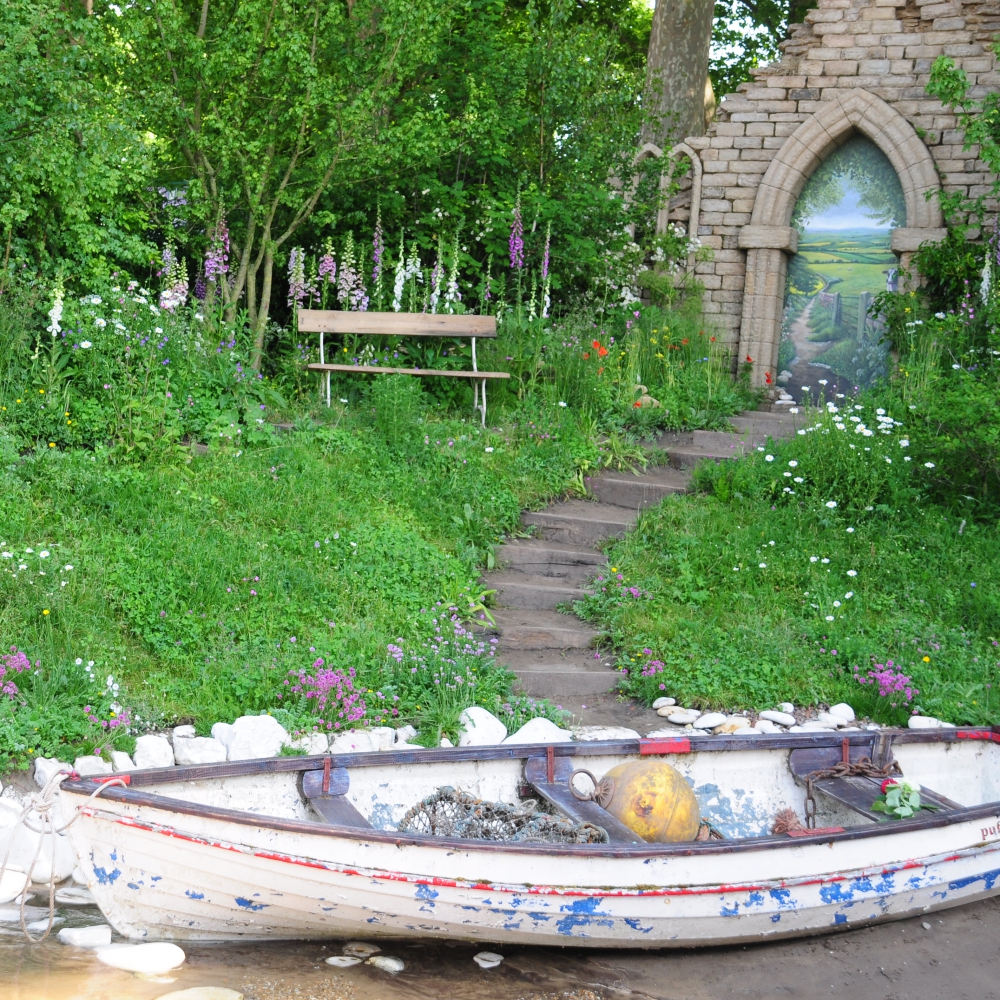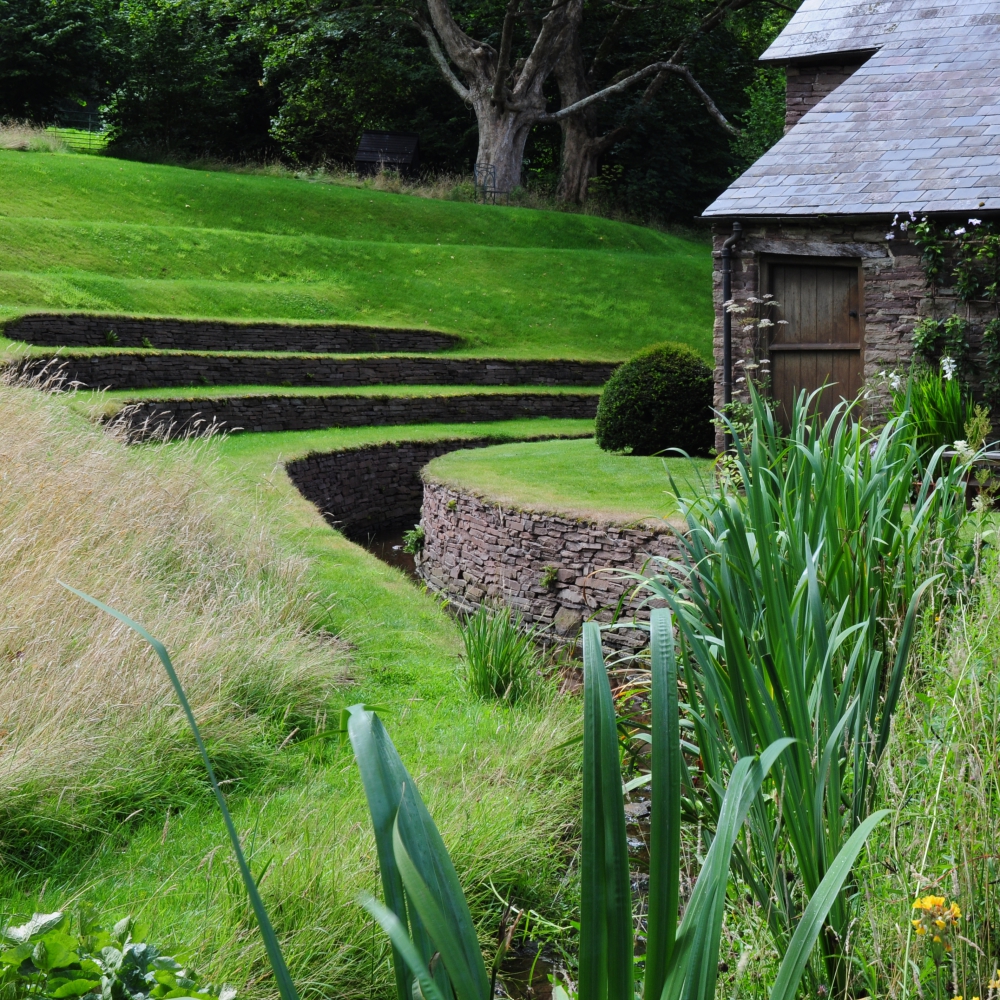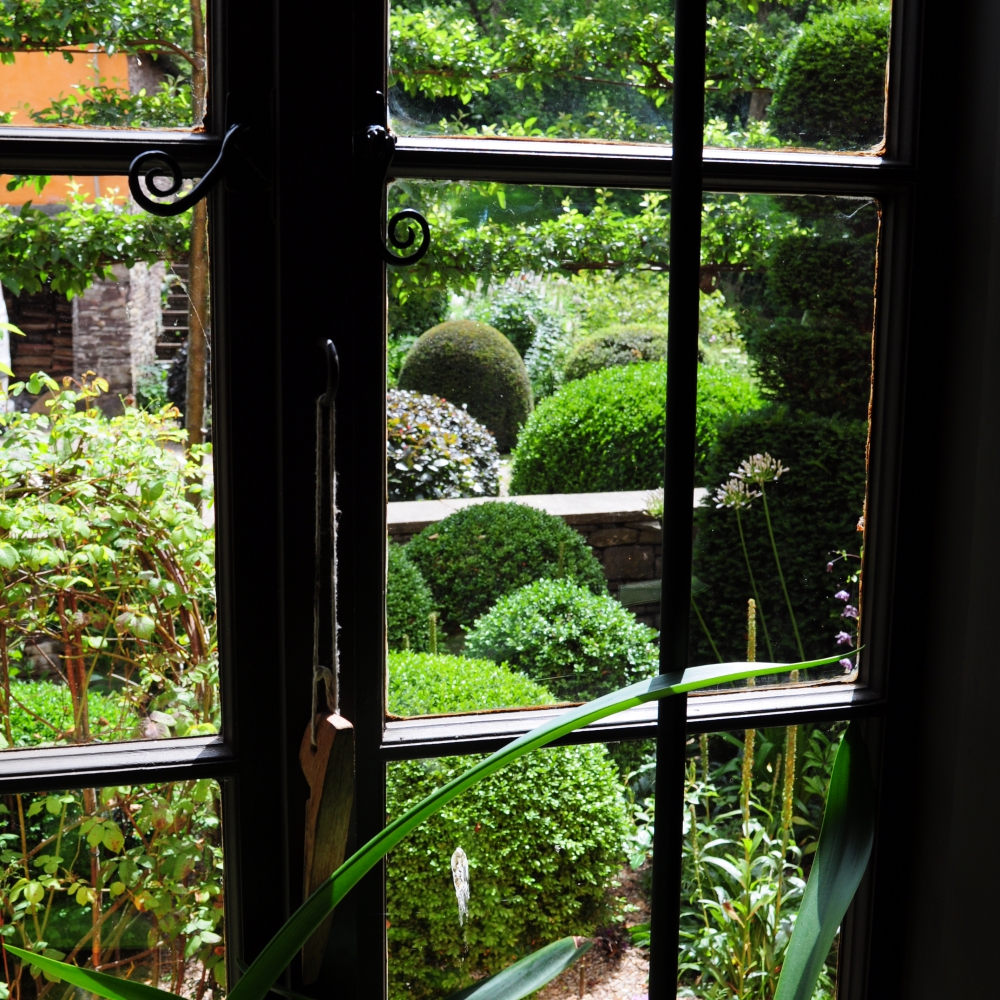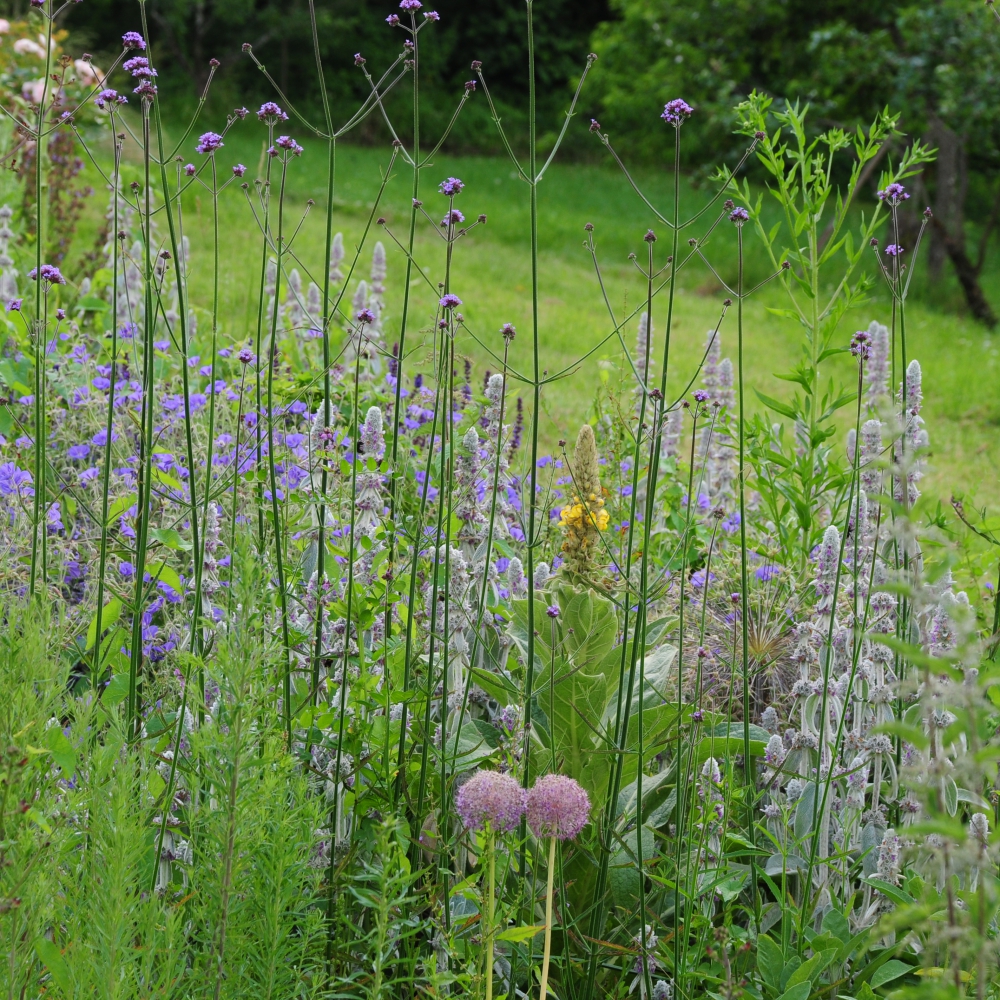2023, a year in photos
I googled “what will 2023 be famous for?” There were some forecasts - war, climate catastrophe, financial turbulence and technological change - so far, so predictable. But a fashion trend for blackened teeth thankfully hasn’t come to pass (or did I miss it?).
Wimbledon Common in January
The year started with a famously cold January. It was a near record of eight days in a row of freezing temperatures. Whilst Wimbledon Common looked fab in the heavy frost the weather took its toll in the garden. Many people lost plants, in particular Hebes, Erigeron karvinskianus and Penstemons. They were hard to replace initially as the frost had affected so many gardens as well as suppliers in the UK and Europe.
Cyclamen at Wakehurst Place in February
One answer to this is to plant a winter garden, full of plants that look their best at this time of year. I went to visit Wakehurst Place which has a fairly new winter garden. It didn’t disappoint and partly as a response to this we have developed a couple of winter borders in my local park.
Magnificent magnolia in Bushy Park in March
A persistent easterly wind in March and April meant that spring felt like a long time coming but finally, after a few false starts, I got on a plane for the first time in three years to go to the garden island of Madeira.
Fanal Forest, Madeira, in April
There were gardens aplenty on the island but one of the most fascinating sights was the ancient laurel forest on the north slope. Subject to frequent fog and mist the trees were already mature when the Spanish arrived in the 14th century. It is an eerie place and, as I found, it’s very easy to get lost.
Bluebells in the Surrey Hills in May
May was a busy month. The weather warmed up a little and I found a great new bluebell wood in the Surrey Hills. The sun also came out for the Chelsea Flower Show and there was only one garden everyone was talking about - Sarah Price’s iris garden. It wasn’t overrated, almost worth the ticket price on its own.
Chelsea Flower Show in May
Also in May I finished planting a new garden in Wimbledon. Throughout the year I have continued as a volunteer gardener in my local park. Luckily the summer wasn’t quite as scorching as 2022. The ox-eye daisies in a wildflower part of the park were stunning in June.
Ox-eye daisies in June
All through 2023 I have been learning how to use a 3D design software package. It has been challenging to say the least but considerable progress has been made. I’m not sure I’ll ever reach guru status, but it’s good to get to a stage where clients can see their prospective gardens in 3D and even walk through them. I haven’t had a client yet say they prefer the old hand-drawn way of doing things.
Cedar greenhouse in July
In July I caught up with a friend who I’d helped with the layout of her garden ahead of the installation of a new greenhouse.
Waterperry Gardens in August
In August there was an overload of garden visits to Ham House, Waterperry Gardens and the best garden I’ve seen in a long time, Le Jardin Plume.
Le Jardin Plume, Normandy in August
Whilst in France I also visited the garden festival at Chaumont and the formal gardens at Chenonceau.
Chenonceau in September
Autumn took a long time to arrive, an unexpected heatwave followed by what seemed like endless rain, and then finally, some spectacular colour. Piet Oudolf describes a fifth season, somewhere between summer and autumn. The garden at the Hepworth Wakefield is a great example of how good a garden can look at this inbetween time.
Allium sphareocephalon and Perovskia in October
And my photographic year ends there, somewhat abruptly. The big camera is out of action and the camera on my phone doesn’t really cut it as a replacement. Normal service will be resumed shortly, hopefully in time for some winter photography.
Gardening to the rescue - the Hampton Court Flower Show
It’s hard to believe things have returned to normal. Is that because our new normal is anything but? The 2021 Hampton Court Flower Show is the first of the RHS’s shows to open after nearly 18 months of cancellations and delays. There was no social distancing but you had to have proof of two vaccinations or a recent test to get in and you still had to wear a mask in the marquees and loos. What really made it feel normal though was the torrential rain, for an hour at least. It was July afterall.
The first of the show gardens we came across was Mike Long’s aptly named A Place To Meet Again. The meeting again is more to do with meeting previously used materials like scaffold boards, old taps (surely a bit too shiny to have had an earlier life?) and a water harvesting tank (oh yes I’ve got one of those lying around, I always wondered what I could use it for) than getting together with friends and family again. That said, I really liked this garden, especially the green and white plant palette, the use of the grey paving in different shapes and textures and the water harvesting tanks cut up to make a sculptural feature and a seat.
Environmental issues were to the forefront in this show - how to adapt to climate change, how gardens can improve our environment, physically and mentally, how to get started in gardening and the consequences of not taking any of these issues seriously.
Jamie Butterworth’s Feature Garden for a greener future (more about Feature Gardens later) showed how gardens and planting could evolve to adapt to wetter winters and hotter, drier summers with drought resilient plants on mounds and ditches for water run-off and damp-loving plants. From a distance the seating area looked attractive, surrounded by lush vegetation. However, my frequent gripe about show gardens is that they are designed more with tv in mind than with paying show visitors and that is definitely the case here.
In stark contrast is Felicity O’Rourke’s Extinction garden. A salvaged passenger plane (Felicity used to be an airline pilot) shows the effect of our lifestyle, reliance on a very small number of plants to feed us and exploitation of natural resources could cause a sixth global extinction. This design was the most shocking and graphic of the show gardens and was quite a talking point amongst visitors.
Tracy Foster’s Message in a Bottle garden is all about plastic, waste and how plants can be used to replace many materials. For example, the oil from flax can be used as a plastic liner alternative.
Outdoor living and the closeness to nature of Norwegian life was the focus of Will Williams’ garden. The planting and hard landscaping was beautiful, althought the feature waterwall didn’t really feature as I didn’t notice there was water pouring down it.
Back to the Feature Gardens. There were a number of show gardens that were not up for judging. These included the Cut Flower Garden above (these amazing Cosmos bipinnatus are called Velouette), Jamie Butterworth’s Garden for a Greener Future and Tom Stuart-Smith’s Iconic Heroes garden below. They are not judged because they are sponsored by the RHS.
This begs a couple of questions - why are there so many gardens sponsored by the RHS, and does judging really matter? Two of the four Feature Gardens were designed by big names in the garden industry and in all likelihood would have little difficulty in attracting outside sponsorship (or winning gold medals). Jamie Butterworth’s garden was designed to a specific RHS message I suppose and Tom Stuart-Smith’s was a sort of tribute to his career (although he has done a number of these sponsored RHS gardens in recent years).
Generally I find visitors to the Hampton Court Show are less obsessed with medals than those at Chelsea. Even to novice show visitors it is obvious which gardens are better than others. This Garden of Solitude won a bronze medal. It’s good in parts but as a whole doesn’t really deliver on the idea or the implementation. It doesn’t feel anymore peaceful than other gardens at the show, the planting looks a bit random and as for the blue wall…. So why does the RHS bother with medals at all? Surely most of the poor designs are weeded out at the proposal stage. Does the competition for gold medals result in better show gardens? What do you think?
I wasn’t that keen on Amanda Grimes’ Punk Rockery garden to begin with but I had a long time to look at it waiting for a friend to navigate the queue for the loos. Closer inspection and then looking it up it shows what you can do with an unpromising site of rubble and little money.. There is a plant for every type of soil and aspect and many will thrive on almost complete neglect. If the last 15 months have shown us anything it’s that gardening is a deeply ingrained behaviour that can be extremely rewarding. Plants will try really hard to stay alive and will grow in less than ideal conditions so why not just have a go?
My Best in Show award goes to Will Williams’ Legacy Garden for Cancer Research UK. The planting was beautiful and the message strong, emphasised by the enthusiastic staff on the garden.
One thing that’s not changed is the excruciating price of food and drink (or the lack of places to shelter in the rain). My advice as usual is to splash out on the coffee or Pimms and take your own picnic. My friend Joy’s picnic was so good a few people asked us where we got it.
Roll on Chelsea 2021.
Wimbledon planting project
In the summer of 2017 I was contacted by A and M and asked to design a new planting scheme for their back garden.
Although the lawn was in very good condition, and even had a mowing strip, most of the rest of the planting left quite a bit to be desired.
Some of the shrubs had been pruned in a supermarket carpark style and the weeds had been left to their own devices for quite some time. There were also a couple of dead and dying trees to take out.
We had a huge clear out of most of the shrubs, a tree surgeon took care of the dead and dying trees, grinding out the stumps where necessary, and then followed the mother of all weeding sessions. Finally the garden was ready for planting.
The colour palette was based partly on some of the plants already in the garden, mostly blue and purple. The rest of the scheme was a cheeky combination of white, orange and dusky pink.
There wasn’t much to see in the first autumn but by March, despite the Beast from the East, and the Mini-beast, the bulbs were making a brave appearance.
The first of the perennials to get going was Geum Totally Tangerine, so good it flowered twice. This was followed by Papaver Patty’s Plum, almost good enough to eat.a
Despite the scorching sunshine and relentlessly high temperatures, and thanks to a lot of watering the rest of the perennials flowered through June and July.
The weeding was relentless. That’s what happens when weeds are left unattended and then you fertilize the soil and water the germinated seedlings.
Some plants, including the delicate Echinacea pallida, suffered at the paws of a youg dog. And some were trampled to death, yes really, by pigeons scavenging underneath the bird feeder.
The planting has performed really well, despite the extreme weather of 2018. Now in September, it’s still looking good.
We’re looking at doing a bit of editing. Some parts of the garden are shadier than I thought, and some drier, even though there’s an irrigation sytstem. And some of the plants savaged by the puppy need to be replaced.
But this is all part and parcel of gardening. Nothing stays the same, some things do better and some things do worse than you expect.
I’ll leave most of the perennials standing through the winter and cut them all back in February. That will be a good time to move some of the grasses from the shade to the sun.
Fingers crossed there won’t be quite as many weeds in 2019, and hopefully the weather will be a bit more benign….
2018 - A good year?
Is 2018 - a good year to remember, or not? Maybe not for some reasons, but, politics aside, ignoring natural and man-made disasters, bad tempers and bad news in general, here is the good news round up of 2018 in the small corner of the world occupied by Arthur Road Landscapes.
A new year, a new day and a new camera on the beautiful island of Barbados. Not too much in the way or horticulture here but when the landscape looks like this who needs a garden?
But of course I couldn’t resist another visit to Hunte’s Gardens.
Having cleverly avoided the Beast from the East, but running full pelt into the Mini-beast, I made a beeline for the Palm House at Kew for a bit of warmth and humidity.
The cold winter and the sudden arrival of a very warm, but late, spring (who knew what was to come?) meant a very good year for bluebells. This little woodland of oak and ash was discovered by my parents in deepest Berkshire.
May means Chelsea. This was my favourite garden, by Sarah Price. Not everyone’s cup of tea, but definitely mine, I’m just waiting for a commission for somewhere in the Med…
At the end of May I visited Lukesland on the edge of Dartmoor. Spring was a little later here so this Wisteria was still in its full glory.
June sees the climax of our native wild flowers. Driving around Surrey I love the road side verges covered primarily in ox-eye daisies. Parts of the M25 are quite spectacular, something to enjoy whilst sitting out a traffic jam. It’s quite tricky finding somewhere to park and photograph them (I haven’t stopped to take any photos on the M25 I hasten to add).
The heat wave started around the middle of June I seem to remember. I went to Loseley Park before the weather began to take its toll and the White Garden here was looking splendid. Of course the thing about white gardens is that they’re not completely white.
July and August seem to have been swallowed up in a blaze of sweltering heat and guilt about using a hosepipe (sorry/not sorry) but at the end of summer I went to The Homewood in Surrey. I hadn’t expected much of the garden but even I was charmed by the heather, Scots pines and rhododendrons.
A very busy autumn meant little time for visiting gardens but I did manage to get the odd half hour or so on Wimbledon Common. Being outside in bright sunshine whenever possible is my way of dealing with short days and long dark nights.
This is beginning to sound like I haven’t done much work in 2018. Well it’s been a funny old year, a mixture of feast and famine. This sweet little courtyard in Twickenham was completed early in the year. The owners are bird mad so hopefully this spring will see a few new residents in the bird boxes.
A large back garden project which has taken a couple of years, was finally planted in October. There’s not too much to see plant-wise at the moment but I’m looking forward to seeing it develop next year.
Maybe not a vintage year but not a bad one either.
Like these photos? Follow me on Instagram.
The best long-flowering plants
At the height of summer some gardens are beginning to run out of steam. I'm always on the look-out for flowers that have staying power and these are some of my favourites.
Verbena bonariensis is one of the most requested plants by my clients, even if they don't know its name. It flowers on tall wiry stems from June until mid-autumn and will only lose its structure after a heavy frost. It doesn't live long but as any gardener will tell you Vb self sows with complete abandon, almost to the point of being really annoying. Give it lots of sun and almost any soil except really heavy clay. Vb's little brother Verbena lollipop grows well in a pot if you're strapped for space.
Looks good with Echinacea purpurea, Helenium Waldtraut and Calamagrostis x acutiflora Karl Foerster.
Anthemis tinctoria starts a bit earlier in the year. Most, like A.t. Sauce Hollandaise or EC Buxton, prefer light and free draining soils and should be cut back hard after flowering. They make good cut flowers if you can bear to take them out of the garden.
Looks good with Geranium Rozanne, Knautia macedonica and Verbascum chaixii.
One of the stars of the late summer garden Aster x frikartii Monch starts flowering in July and will go ontil mid-autumn. Loved by insects, this plant likes fertile soil with some moisture to produce its best efforts although it will survive most conditions.
Looks good with Euphorbia characais Humpty Dumpty, Penstemon Alice Hindley and Rudbeckia fulgida var, sullivantii Goldsturm.
Penstemon Garnet is my go-to plant for a reliable red flower that doesn't get powdery mildew and lasts more than one summer. Like many plants in this list it likes full sun and fertile soil. I've had some disasters with heavy clay soil. It is not 100% frost-proof so whilst I dead-head it through the summer I don't cut it back fully until early spring. Confusingly this is also callled Penstemon Andenken an Friedrich Hahn and you will often see both names on the label. Most Penstemons are equally long-flowering and other favourites of mine include the deep purple P. Raven and the light blue P. Alice Hindley.
Looks good with Centranthus ruber Alba, Pennisetum Red Buttons and Salvia sylvestris Dear Anja.
Another great red flower, Potentilla Gibson's Scarlet is at the fire-engine end of the spectrum. It's great for the front of the border but give it plenty of room as the flower stems reach out further than you would think if planting early in the year. Full sun and well-drained soil will keep the plant happy.
Looks good with Geum Princess Julian, Agapanthus Black Pantha and Gaura lindheimeri Siskyou Pink.
If you can only have one of these plants in your garden this is the one I'd go for. Rudbeckia fulgida var. sullivantii Goldsturm flowers from July until late autumn and continue to look good through the winter if the weather is not too wet and windy. And, even better, it loves heavy clay soils, perfect for London.
Looks good with Helenium Moerheim Beauty, Verbena bonariensis and Phormium Yellow Wave.
Rosa Iceberg can be grown as a shrub but as it is pretty vigorous I think it's better as a climber. It produces a magnificent flush in June and if you dead-head properly it will continue to flower on and off until December. It doesn't have a strong scent but is usually pretty healthy. Like most roses is is as happy as Larry in clay soil.
Looks good on its own.
Winner of the RHS Flower of the Decade competition Geranium Rozanne doesn't really get into its stride for a month after most of the other blue Geraniums like G. Orion or G. Johnson's Blue. But once it does get going there is no stopping it, most I know go on until November and they don't need dead-heading. It will even grow in quite a bit of shade but for the best results plant in full sun in almost any soil except that which is waterlogged.
Looks good with Persicaria amplexicaulis Firetail, Phlomis russeliana and Salvia nemoraosa Caradonna.
The poster flower for the millenial trend of prairie planting Echinacea purpurea will probably outlast many others that don't like the general dampness of our climate. Strikingly architectural, even after the colour has faded, they are a favourite of gardeners and pollinating insects alike. It can take a few years to bulk up so it's not a plant to be impatient with. It likes full sun and well-drained but not dry soil - not picky at all - but worth it. This one is E.p. Magnus Superior but there are many different varieties and colours. I've not had much luck with the orange ones but E.p. White Swan is a reliable and good-looking culltivar.
Looks good with Gaura lindheimeri Whirling Butterflies, Sedum spectabile Autumn Joy and Calamagrostis brachytricha.
And finally, Erigeron karvinskianus, sometimes called E.k. Profusion or Mexican Fleabane. This is the plant you will see self-sown in the paving at National Trust properties. It flowers ceaselessly from May until November and does not need dead-heading; the newly emergent flowers are white, fading to pink as they age. It's great at the front of the border, keeping weeds at bay with its carpeting growth, and I like to plant it in pots. It's fairly unfussy about the conditions it grows in making really good value for money and it's self-sowing habit means it's quite difficult to kill!
Looks good with Olea europea, Stipa tenuissima and Sisyrinchium striatum.
Return to Allt-y-bela
Unable to resist another invitation to see Allt-y-bela, I trogged down the M4 in the pouring rain.
Last time I was here it was raining too. But, like then, the sun did come out, briefly. In late July this garden is all about the cottage garden and the vegetable plot. In early June it's all roses and wild flowers
It's the wild flower meadows that help the garden merge with the surrounding landscape. Of course they're not really wild in the sense of always having been here; they haven't, they've been planted and sown in the last ten years, but you wouldn't know it just by looking.
But even old wild flower meadows need to be managed - mown at the right time to allow seeds to fall and germinate, the flowers not allowed to lie in situ after mowing but be picked up so the soil fertility doesn't increase and additional species planted that may or may not be typical wild flower meadow plants. Like these Trollius.
The meadows are in fact quite a bit of work, but definitely worth it I think.
The roses were over by the time of my visit last year but this time they were just getting into their stride. I'd love to be able to tell you the names of them all but I found myself a bit distracted.
As the garden is in a bit of a valley the scent is captured and remains in the air, even on a wet day.
Often I have clients say they don't want any roses in their gardens. Memories of municipal monoculture or a faint whiff of the crematorium perhaps? But when planted amongst other shrubs or perennials they can really shine when in flower and disappear into the background when they've finished.
And roses' ability to climb makes them doubly useful, especially if you are short of space or have a few old apple trees that might not be looking their best.
Having a beautiful house does give you a bit of a head start in the gardening stakes. It does take a degree of bravery to turn an off-white ugly duckling into an uskan orange beauty (yes the typo is deliberate).
And when garden designers witter on about good bones and structure this is what they are refering to - good quality hard landscaping that has a beauty and a purpose and fantastic evergreen plants.
Or purple ones.
Chelsea 2017 - the best bits
I don't quite know when the RHS knew that some of it's most constant sponsors had pulled out of the 2017 show, but there was no attempt made at reducing the ticket prices. However, it was still sold out.
In theory this should have been a good year for some designers as arguably there was less competition. There was only one really big gun in the world of tv horticulture - Chris Beardshaw. But even though his was clearly the most popular garden with the public he could only garner a silver-gilt. I didn't see enough of the tv coverage to find out why but if I had to guess I would say the planting was a bit "busy". Though this is precisely what a lot of people liked about the garden - the sheer range of colour, texture and form.
It was a garden of two halves, one bright and colourful, the other more textural and green. It was impossible to get a photo of the garden as a whole, mainly because the crowds here were the deepest and most constant through the whole day I was there.
Best in Show went to James Basson, a designer based in the South of France. In the well-known game, I have only two degrees of separation to James Basson as he is designing the Provence garden of one of my London clients.
His gardens are rarely everyone's cup of tea as they are based on Mediterranean plants put together in a sustainable way that requires very little in the way of soil improvement or irrigation. This is precisely what my client wants for her new garden, but it's not exactly traditionally "English". This garden rekindled the debate about where gardens end and wild landscapes begin. In an era of increasing awareness about sustainability in general and the effect our changing climate is having on gardens in particular this is a trend that is likely to continue and develop.
One garden that combined traditional English with a wild landscapes was the Welcome to Yorkshire garden. I've not been to the bit of the coast, Whitby, that this garden represents but I find it hard to imagine how this would survive some typical "northern" weather. I loved the boat but the mural in the folly was quite naff.
Newcomer Charlotte Harris's garden for Royal Bank of Canada was also based on an interpretation of a wild landscape. I really liked this garden (even though it was difficult to photograph) and it would be easy to imagine it sitting well in parts of Scotland that have brief but intense summers with very long days.
One of the key plants in the Royal Bank of Canada garden was the Jack Pine and 2017 was surely the year of the pine in its many forms. The Radio 2 gardens were a welcome addition to the repetoire at Chelsea and helped fill some of the gaps left by fewer main show gardens. I particularly liked the Texture Garden designed by Matt Keightley.
One of the most regular designers at Chelsea is Kazuyuki Ishihara. Ths was another garden that was really popular with the Chelsea visitors. It is an exercise in the minature with each detail exquisitely crafted, demanding close attention.
I'm no expert on Japanese gardens other than knowing they are usually a stylised representation of nature and man's place in it. This garden was one an increased number of Artisan's gardens, demonstrating the combination of traditional skills with horticulture.
i thought the overall standard of the Artisan gardens was higher than usual and some of them were entertaining. Some of my favourites included Dr Catherine MacDonald's garden for Seedlip. The copper piping weaving through the planting was fun.
The metal work continued into Graham Bodle's reclammation of an industrial site into a garden. I love a bit of rusty metal... and look, more pines.
'm normally a big fan of Sarah Eberle, a former winner of Best in Show. This Viking Cruises garden didn't do much for me but I did like some of the plants, particularly this cactus.
For my final garden there is only one degree of separation. The Breaking Ground garden was designed by Andrew Wilson and Gavin McWilliam; Andrew was my tutor when I studied garden design. The duo finally won a gold medal with this garden after several near misses (somewhat painful for Andrew who is a former head judge at Chelsea). It just shows what you can do with a lot of experience, a loyal sponsor, determination and ambition. And, what is that tree in the background?
Allt-y-bela
Allt-y-bela is designer Arne Maynard's garden in Monmouthshire. Initially, it was Arne's intention to make a simple garden using his favourite components - roses, topiary and wildflower meadows. There was no garden here when Arne bought the restored medieval farmhouse five years ago, just a few outbuildings set across an ancient drover's road.
The topiary, mostly set around the house, is huge and dramatic, and seemingly randomly placed. His gardener, Steve, said it was not unusual for Arne to receive deliveries of large pieces without much forethought as to where they would be placed.
None of the pieces are alike and there is no attempt at placing them in a formal pattern. The larger pieces are a mixture of yew, hornbeam, purple beech and box. Low hawthorn hedges have just been planted to create rustic edges for the few formal borders.
There is a pleasing lack of formality to the garden as it is the designer's intention to blue the boundaries between the garden and the wider landscape. Beyond the immediate vicinity of the house the garden is surrounded by wildflower meadows. At the end of summer the flowers have all faded but in spring thousands of bulbs are in flower, designed to make the meadows look as though they've been there for hundreds of years.
In keeping with the house's agricultural history there is a productive and beautiful Kitchen Garden.
By the way, the house was white when Arne bought it. I don't know how he came to choose orange as the right colour to paint it but it makes a stunning backdrop to the garden, mainly because green really stands out against it. And when you've got an orange house you need a few orange flowers.
Next to the Kitchen Garden is the Cottage Garden, full of flowers to be cut for the house. The paths are made from stone found around the house and are angled to provide interesting glimpses of other parts of the house. These foxgloves are Digitalis ferruginea gigantea.
Despite his best intentions Arne has been unable to resist the urge to go beyong his original brief. The stream behind the old granary has been canalised with local stone and divides the stage from the terraces that form the Garden Theatre.
The gardens immediately outside the house are more complex, though still informal.
The Courtyard Garden at the front is enclosed with a pleached hedge and filled with smaller pieces of topiary and cottage-style planting, making for an interesting view from the kitchen.
One of my favourite spots in the garden is at the back of the house. Box hedging reaches out towards the meadow.
It is here the roses are most in evidence. Although by late summer they are mostly past their best they must look and smell amazing in June.
Back towards the front of house, next to the granary, is Arne's latest project, the Lattice Garden. Low hedges of hawthorn frame herbaceous planting and topiary.
espite being a two-time gold medal winner at Chelsea, there's still room a little whimsy in the garden (or was it there already when he bought the property?).
Little of this garden would be possible without full-time gardener Steve Lannin. Although the topiary is only trimmed once a year apparently it can take weeks to get all the way round the garden. Steve was a warm and knowledgeable host on our visit and really brough Arne's design ideas to life.
t is difficult to explain how much I enjoyed this garden; it's quite different to any other garden I have seen. There really is a blurring between the garden and the wider landscape and the huge topiary adds unexpected scale and drama. I didn't feel as though I were in a garden in the normal sense - there were no boundaries - just endless possibilities of walking round the garden with different views at each turn. Quite an achievement.
The garden at Allt-y-bela is not open to the public but group visits can be arranged. Alternatively, you can stay in the house as a B&B and have the garden all to yourself.
Allt-y-bela - http://arnemaynard.com/portfolio/gardens/my-garden-in-wales/#.V8bC9aJM1YU
Steve Lannin's garden diary - http://arnemaynard.com/journal/garden-diary/?tag=Steve%20Lannin#.V8bDcaJM1YU
The Hungry Cyclist's Garden
I've just returned from a fab five days in Burgundy, staying at the beautiful Le Moulin Prunier, home of the Hungry Cyclist, Tom Kevell-Davies. Restoring the old mill as a guest lodge, running cycling tours, cooking, brushing up on his wine knowledge (for research purposes only) has been a labour of love for the past four years.
The Mill is set in five acres of land, including a stream, mill pond, orchard and nuttery and a garden. Unusually for me I was up most mornings at 5.30am and I finally discovered why most garden photographers think this is the best time of day. The light is soft, the shadows long, there is still dew on the ground and, most importantly, no one else is around.
The English Border, as I like to call it, was initially dug over by wild boar. The perennials here are mostly gifts and swaps with a few purchases.
At this time of year there is a predominance of soft blues, purples and grey
Stunning when back-lit against the early morning sun.
At the top of the garden is the mill pond. It was fascinating to see how this changed with the different light and weather conditions.
Early in the morning, before the sun falls on it, the water is a deep and cool green. A kingfisher uses this bird house as a fishing perch apparently.
After a huge thunderstorm the water level rose nearly a foot in height. Most of the plants became submerged and the water fully reflected the surrounding foliage.
Successful country gardens reflect and draw on the countryside around them. Tom's garden is no exception, with views of the vineyards that surround the village. Pinot noir and chardonnay, if you're wondering.
Tom's other passion is collecting - cycling memorabilia and bric a brac. The garden contains a few well-placed pieces of furniture, including this old bench.
This bridge across the stream is made from an old wine barrel, quite a large one by all accounts.
I couldn't work out if this collection of pieces was deliberate or random in its placing, next to the cellar.
During my stay I was lucky enough to borrow a macro lens for a day. It was quite tricky to get the hang of (more practice needed), but some beginner's luck resulted in a few good shots.
Tom is aided and abetted by the delightful Mirabelle.
Really the best thing about being up this early is that someone else has made breakfast, ready just when you need it.
A big thankyou to Tom, Desna, Susannah, Sarah, Chris and Rob for a fab holiday.
The Hungry Cyclist Lodge - http://www.thehungrycyclist.com/



















